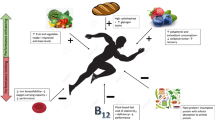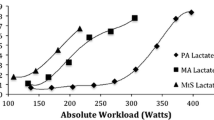Abstract
Changes in the concentrations of thiobarbituric acid-reactive substances (TBARS), an index of lipid peroxidation in liver, heart and soleus muscle, were studied in trained (T) and untrained (U) rats throughout a period of 48–72 h following running until exhaustion. Creatine kinase (CK) concentration in serum was also determined. The running time till exhaustion in group T was significantly longer than in group U [174.5 (SEM 9.8) vs 92.7 (SEM 8.3) min,P < 0.01]. In group U TBARS concentration in investigated tissues increased significantly (P < 0.01) after exercise with the peak values observed 3 h after running. The post-exercise increase in the TBARS concentration persisted longer in the soleus muscle (48 h) than in the liver or heart (3 h). A postexercise increase of TBARS was observed in group T only in the liver. The influence of training on the TBARS content depended on the kind of tissue. The TBARS concentrations in the liver at rest and immediately after the exercise were lower in group U than in group T. In contrast, TBARS concentrations in the heart and soleus muscle were higher in group U than in group T. The exercise resulted, in both groups, in a rise of serum CK concentration, peak values being observed 3 h following the exercise. Postexercise concentrations of CK were considerably lower in group T than in group U [3 h postexercise: 1740 (SEM 170) vs 2750 (SEM 231) U · 1−1 P < 0.01]. A positive correlation (r = 0.66,P < 0.05) between TBARS content in muscle and serum CK concentration was found only in group U. The results obtained indicated that the generation of lipid peroxidation products in the soleus muscle was intensified for a relatively long time after the exercise. Endurance training decreased the susceptibility of tissues to the action of free radicals. However, this influence of training was more pronounced in the heart and soleus muscle than in the liver.
Similar content being viewed by others
References
Armstrong RB, Ogilvie RW, Schwane JA (1983) Eccentric exercise-induced injury to rat skeletal muscle. J Appl Physiol 54:80–93
Criswell D, Powers S, Dodd S, Lawler J, Edwards W, Renshler K, Grinton S (1993) High intensity training-induced changes in skeletal muscle antioxidant enzyme activity. Med Sci Sports Exerc 25:1135–1140
Davies KJA, Quintanilha AT, Brooks GA, Packer L (1982) Free radicals and tissue damage produced by exercise. Biochem Biophys Res Commun 107:1198–1204
Faff J, Dudkiewicz J, Józefczak E (1988) Effect of NaHC03 treatment on exercise induced rise of some serum enzymes levels. Biol Sport 5:5–9
Gauduel Y, Menasche P, Duvelleroy M (1989) Enzyme release and mitochondrial activity in reoxygenated cardiac muscle: relationship with oxygen-induced lipid peroxydation. Gen Physiol Biophys 8:327–340
Higuchi ML, Cartier J, Chen M, Holloszy JO (1985) Superoxide dismutase and catalase in skeletal muscle: adaptive response to exercise. J Gerontol 40:281–286
Janero DR (1990) Malondialdehyde and thiobarbituric acid-reactivity as diagnostic indices of lipid peroxidation and peroxidative injury. Free Rad Biol Med 9:515–540
Jenkins RR, Krause K, Schofield LS (1993) Influence of exercise on clearance of oxidant stress products and loosely bound iron. Med Sci Sports Exerc 25:213–217
Ji LL (1993) Antioxidant enzyme response to exercise and aging. Med Sci Sports Exerc 25:225–231
Ji LL, Stratman FW, Lardy HA (1988) Antioxidant enzyme system in rat liver and skeletal muscle: influences of selenium deficiency acute exercise and chronic training. Arch Biochem Biophys 263:150–160
Jones DA, Newham DJ, Round JM, Tolfree SEJ (1986) Experimental human muscle damage: morphological changes in relation to other indices of damage. J Physiol (Lond) 375:435–448
Kanter MM, Lesmes GR, Kaminski LA, Ham-Saeger JL, Nequin ND (1988) Serum creatine kinase and lactate dehydrogenase changes following an eighty kilometer race. Eur J Appl Physiol 57:60–63
Kihlstrom MT (1990) Protection effect of endurance training against reoxygenation-induced injuries in rat heart. J Appl Physiol 68:1627–1678
Kihlstrom MT (1992) lipid peroxidation capacities in the myocardium of endurance-trained rats and mice in vitro. Acta Physiol Scand 146:177–183
Komulainen J, Vihko V (1994) Exercise-induced necrotic muscle damage and enzyme release during a four-day period following prolonged submaximal running in rats. Pflügers Arch 428:346–351
Kosano H, Kinoshita T, Nagata N, Takatani O, Isobe M, Yazaki Y (1986) Changes in concentrations of myogenic components of serum during 93 h of strenuous physical exercise. Clin Chem 32:346–348
Kuipers H, Drukker J, Frederik PM, Geurten P, Van Kranenburg G (1983) Muscle degeneration after exercise in rats. Int J Sports Med 4:45–51
Lovlin R, Cottle W, Pyke I, Kavanagh M, Belcastro AN (1987) Are indices of free radical damage related to exercise intensity. Eur J Appl Physiol 56:313–316
Maughan RJ, Donnelly AE, Gleeson M, Whiting PH, Walker KA, Clough PJ (1989) Delayed onset muscle damage and lipid peroxidation in man after a downhill run. Muscle Nerve 12:332–336
Miles MP, Schneider CM (1993) Creatine kinase isoenzyme MB may be elevated in healthy young women after submaximal eccentric exercise. J Lab Clin Med 122:197–201
Ohkawa H, Ohishi N, Yagi K (1979) Assay for lipid peroxides in animal tissues by thiobarbituric acid reaction. Anal Biochem 95:351–358
Packer L (1986) Oxygen radicals and antioxidants in endurance exercise. In: Benzi L, Packer L, Silipiandi N (eds) Biochemical aspects of physical exercise. Elsevier Science, New York, pp 73–92
Panczenko-Kresowska B, Hubner-Woźniak E, Ziemlański S, Woźny E, Dziedziak W (1991) Effects of physical exercise on the changes in antioxidant levels in speed skaters. Biol Sport 8:19–24
Quintanilha AT (1984) The effect of physical exercise and/or vitamin E on tissue oxidative metabolism. Biochem Soc Trans 12:403–404
Rajguru SU, Yeargans GS, Seidler NW (1994) Exercise caused oxidative damage to rat skeletal muscle mikrosomes while increasing cellular sulfhydryls. Life Sci 54:149–157
Romson JL, Hook BG, Kunkel SL, Abrams GD, Schork A, Lucchesi BR (1983) Reduction of the extent of ischemic myocardial injury by neutrophil depletion in the dog. Circulation 67:1016–1023
Sahlin K, Ekberg K, Cizinsky S (1991) Changes in plasma hypoxanthine and radical markers during exercise in man. Acta Physiol Scand 142:275–281
Salminen A, Vihko V (1983) Endurance training reduces the succeptibility of mouse skeletal muscle to lipid peroxidation in vitro. Acta Physiol Scand 117:109–113
Schwane JA, Armstrong RB (1983) Effects of training on skeletal muscle injury from downhill running in rats. J Appl Physiol 55:969–975
Singal PK, Kapur N, Dhillon KS, Beamish RE, Dhala NS (1982) Role of free radicals in catecholamine-induced cardiomyopathy. Can J Physiol Pharmacol 60:1390–1397
Singh A (1982) Chemical and biochemical aspects of superoxide radicals and related species of activated oxygen. Can J Physiol Pharmacol 60:1330–1345
Siu GM, Draper HH (1982) Metabolism of malondialdehyde in vivo and in vitro. Lipids 17:349–355
Smith JK, Grisham MB, Granger DN, Korthuis RJ (1989) Free radical defense mechanism and neutrophil infiltration in postischemic skeletal muscle. Am J Physiol 25:H 789-H 793
Steel RGD, Torrie JH (1960) Principles and procedures in statistics. McGraw-Hill, New York
Thomson WHS, Sweeting JC, Hamilton IJD (1975) ATP and muscle enzyme eflux after physical exertion. Clin Chim Acta 59:241–245
Van der Heide RS, Sobotka PA, Ganote CF (1987) Effects of the free radical scavenger DMTU and mannitol on the oxygen paradox in perfused rat hearts. J Mol Cell Cardiol 19:615–625
Viinka L, Vuori J, Ylikorkala D (1984) Lipid peroxides, prostacyclin and tromboxane A2 in runners during acute exercise. Med Sci Sports Exerc 16:275–277
Young D (1974) The origin of serum enzymes and the basis for their variation. In: Blume P, Freier EF (eds) Enzymology in the practise of laboratory medicine. Academic Press, New York, pp 253–269
Author information
Authors and Affiliations
Rights and permissions
About this article
Cite this article
Frankiewicz-Jóźko, A., Faff, J. & Sieradzan-Gabelska, B. Changes in concentrations of tissue free radical marker and serum creatine kinase during the post-exercise period in rats. Europ. J. Appl. Physiol. 74, 470–474 (1996). https://doi.org/10.1007/BF02337728
Accepted:
Issue Date:
DOI: https://doi.org/10.1007/BF02337728




